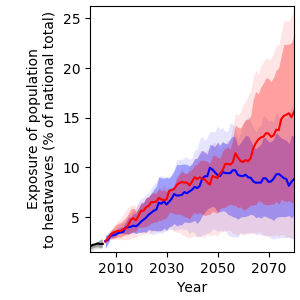Mali: Human health
Climate change threatens the health and sanitation sector through more frequent incidences of heatwaves, floods, droughts and storms. Among the key health challenges in Mali are morbidity and mortality through vector-borne diseases, such as malaria, waterborne diseases related to extreme weather events (e.g. flooding), such as diarrhoea, respiratory diseases, malnutrition, HIV / AIDS, meningitis, injury and mortality through extreme weather events [31]. Climate change can impact food and water supply, which can increase the risk of malnutrition, hunger and death by famine. Scientific investigations found a link between extreme weather events and mortality patterns in Mali: Precipitation events of more than 10 mm per day were negatively associated with survival of children under five years of age, while colder temperatures were associated with lower mortality rates among the general population [32], [33].
Furthermore, climate change is likely to lengthen transmission periods and alter the geographic range of diseases, such as malaria or meningitis. Malaria continues to be the primary cause of morbidity and mortality in Mali, particularly among children under the age of 5 [34]. In some regions, malaria risk will likely increase, for instance, due to higher occurrence of flooding, but overall risk is projected to fall due to rising temperatures [35], [36]. Temperature increases could also lead to more frequent outbreaks of meningitis [37]. Mali is part of the so-called Meningitis Belt, which largely coincides with the Sahel region and which is where the majority of meningitis epidemics occur. Access to health care in Mali remains limited and is being further complicated by armed conflict: According to Médecins Sans Frontières (MSF), many public and humanitarian health organisations have limited or even closed down their operations due to armed conflicts [38].
Exposure to heatwaves

Rising temperatures will result in more frequent heatwaves in Mali, leading to increased heat-related mortality. Under RCP6.0, the population affected by at least one heatwave per year is projected to increase from 2 % in 2000 to 16 % in 2080 (Figure 17).
Heat-related mortality

Furthermore, under RCP6.0, heat-related mortality will likely increase from 2.5 to about 12 deaths per 100 000 people per year, which equals a factor of more than five towards the end of the century compared to year 2000 levels, provided that no adaptation to hotter conditions will take place (Figure 18). Under RCP2.6, heat-related mortality is projected to increase to about 6 deaths per 100 000 people per year in 2080.
References
[31] Centers for Disease Control and Prevention, “CDC in Mali,” Atlanta, Georgia, 2018.
[32] P. Han and J. Foltz, “The Impacts of Climate Shocks on Child Mortality in Mali,” Madison, WI, 2013.
[33] B. Bakshi, R. J. Nawrotzki, J. R. Donato, and L. S. Lelis, “Exploring the Link Between Climate Variability and Mortality in Sub-Saharan Africa,” Int. J. Environ. Sustain. Dev., vol. 18, no. 2, pp. 206–237, 2019.
[34] U.S. President’s Malaria Initiative, “Mali Country Profile,” Washington, D.C., 2017.
[35] R. Boyce, R. Reyes, M. Matte, M. Ntaro, E. Mulogo, J. P. Metlay, L. Band, and M. J. Siedner, “Severe Flooding and Malaria Transmission in the Western Ugandan Highlands: Implications for Disease Control in an Era of Global Climate Change,” J. Infect. Dis., vol. 214, pp. 1403–1410, 2016.
[36] C. Caminade, A. E. Jones, R. Ross, and G. Macdonald, “Malaria in a Warmer West Africa,” Nat. Clim. Chang., vol. 6, no. November, pp. 984–985, 2016.
[37] A. M. Molesworth, L. E. Cuevas, S. J. Connor, A. P. Morse, and M. C. Thomson, “Environmental Risk and Meningitis Epidemics in Africa,” Emerg. Infect. Dis., vol. 9, no. 10, pp. 1287–1293, 2003.
[38] Médecins Sans Frontières, “Violence in Central Mali Has Reached Unprecedented Levels,” 2019. Online available: https://www.msf.org/mali-conflict-curfew-and-floods-put-healthcare-out-reach [Accessed: 24-Feb-2020].


